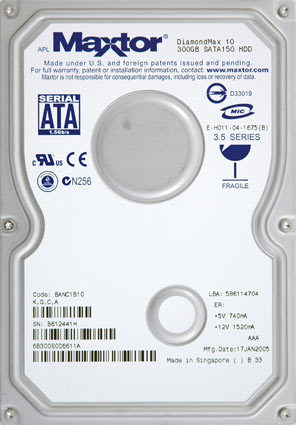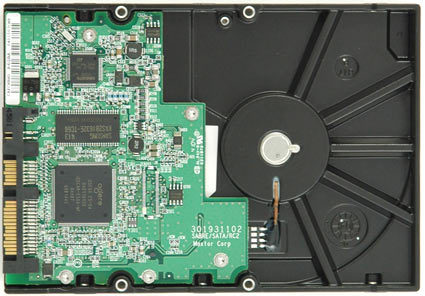Maxtor's DiamondMax 10 A Jewel Reviewed
The DiamondMax 10 In Detail
The DiamondMax 10 is available in various sizes from 80 to 300 GB. As usual, we received the highest-capacity model for review. Maxtor stores around 100 GB per platter and deploys a maximum of three platters in the desktop market, adding up to a total capacity of 300 GB for the flagship unit.
The 80, 160 and 250 GB models are cut down versions of the one, two or three platter designs, with some storage space left unused for marketing purposes. As a result we expect these models to be slightly faster in terms of minimum data transfer rates, since the slower inner media zone is not used.
The key technical data of the drive has not changed much over the last few generations. A typical desktop hard drive runs at 7,200 RPM, offers seek times of less than 10 ms (Maxtor states < 9.0 ms) and uses either an UltraATA or a Serial ATA (SATA) interface. While UltraATA/100 is still fast enough for all desktop models (69 MB/s is the maximum today), Maxtor is an advocate of UltraATA/133. However, native command queuing can only be used with the SATA versions, since the UltraATA protocol does not provide for this type of storage subsystem intelligence. Both interface versions are widely available today, with the UltraATA/133 models being slightly cheaper.
Also, all modern hard drives, including the DiamondMax 10, come with fluid dynamic bearing (FDB). This technology started to replace classis ball bearing motors a couple of years ago, because fluid bearings do not get as hot as classic ones, and also make less noise. This is how the heat and noise levels of 7,200 RPM drives were considerably reduced, and this is evident on the DiamondMax 10 as well.
Get Tom's Hardware's best news and in-depth reviews, straight to your inbox.
Current page: The DiamondMax 10 In Detail
Prev Page Maxtor DiamondMax 10 Next Page Hard Drive Comparison Table
Patrick Schmid was the editor-in-chief for Tom's Hardware from 2005 to 2006. He wrote numerous articles on a wide range of hardware topics, including storage, CPUs, and system builds.

